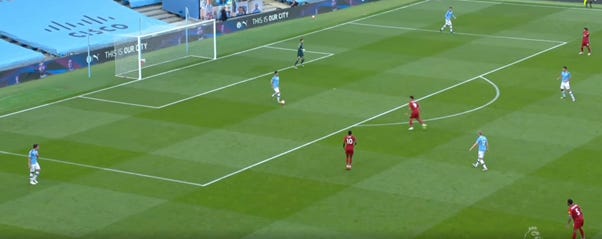The theory underlining the decision for a centre back to pass it to a goalkeeper from a goal kick, seemingly recreating base conditions with the ball being active rather than static, is that it permits delay in deciding a ball-side whilst facing opposition pressure. This allows for a greater degree of horizontal stretching because it prevents the opposition from pistioning to consequently compact and apply ball-side pressure to the same extent, making a direct vertical ball forward into the two higher sitting players is more feasible (assuming that the team in question use a 4-2-4). Should the oppositions midfield compact centrally to prevent this (assuming high man-orientation), the double pivot can more ably receive possession, providing an extra player to circulate around or through the defence. Should the wingers compact, the out-ball becomes the less optimal and more speculative direct pass to the full back; however, should the winger be sufficiently narrow, there should be enough time to receive and carry forward, generating a transition.
Additionally, against man-oriented defensive set-ups the pass to the goalkeeper moreover seeks to undermine the basis as the goalkeeper is still permitted time due to the centre forward having to curve his run to the near-side centre back to cover the pass.
Further it provides a degree of momentum to the ball, which combined with the factor above granting time, can make the likelihood of the pass being successful higher, as the momentum more naturally carries itself, as was exhibited by Anatoliy Trubin against Real Madrid. This seems the key point of differentiation between starting centre back-to-goalkeeper to the then go direct.
Adding onto this, it forces a greater degree of opposition commitment to entice the direct ball, making conditions upon reception better with vision for the subsequent transition as the opponent is further away from their own goal, and directionally committed to moving forward, contrasted to the staticity present from typical goal kick scenarios. Adding the vertical stretching element to the horizontal element, amplifying (value neutral at this stage) the effects deeper build-up.
I would say it then functions similarly to the The Consigli-Boga. The aim is to keep the ball central for as long as possible to maximise potential options and force the opposition to commit centrally to provoke an action, effecting their pitch coverage later on.
The same theory largely applies to back 4’s created by the goalkeeper with a safe central pass into a centre back, where then they split but remain compact and strongly linked. It delays commitment and prevents the opposition from compacting on a ball-side which creates more space to play into. It moreover allows for greater commitment higher up whilst achieving the stretching benefits of a back 4, albeit lacking a safety option, which under higher pressure could encourage greater verticality.
If the pressing team commits (theoretically limited now because of the greater commitment in higher regions without sacrificing access to passing lanes directly), you use the numerical superiority to circulate and find an opening, prioritising central regions first to entice commitment, to then use the wings to access central space around the block. That is not to suggest a line-breaker to the higher central players shouldn’t be attempted, more so, it’s less likely – if the opportunity arises, try it. However, it entails a high degree of risk following a turnover which should influence any progression decision.
Delaying ball-side commitment may have been presented as an overall positive; however, automatisms can function in traditionally counterintuitive ways under the notion of superior knowledge of subsequent actions reducing the time between reception and pass typically assumed, allowing for riskier ventures to be attempted. Just as you may want to entice vertical pressure with the risks associated with such verticality, so to you may desire to attract the opposition horizontally to expose space on the far-side.


